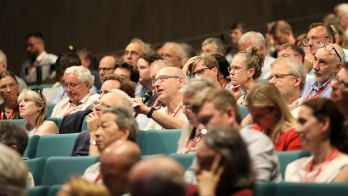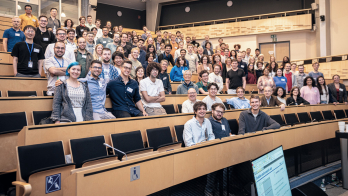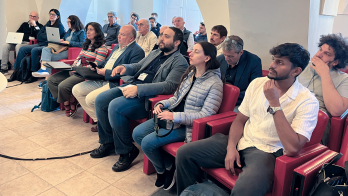Andrei Golutvin explains how quantum phenomena in B mesons may reveal new physics in LHCb.

Unlike the general-purpose detectors, the geometry of the LHCb experiment does not cover the full solid angle, but is developed along the forward direction with respect to the collision point. For 20 m a series of detector planes collects information on the particles coming from the collision point. This design is optimized for the study of B mesons, which, given their relatively small mass compared with the high energy of the LHC collisions, fly mostly in the forward direction.
B mesons have received increasing attention from theorists and experimentalists alike over recent years because their behaviour seems linked to various quantum phenomena that could shed light on new physics. “Today’s Standard Model of particle physics leaves many unanswered questions,” says Andrei Golutvin, spokesperson of the LHCb collaboration. He has recently taken over this role from Tatsuya Nakada who was the first spokesperson and a founder of the experiment. “A lot of physicists expect new physics to be just around the corner and already accessible at the LHC,” he continues. “General-purpose detectors like ATLAS and CMS will look for direct evidence of the existence of new particles. We have a different strategy. We focus on the study of B mesons, where some of their behaviour is very precisely predicted by the Standard Model. However small, a deviation from these predictions would indicate the existence of new phenomena.”
In recent years, two experiments at B-factories – BaBar at SLAC and Belle at KEK – have shown that the B particles are a key element in the process of understanding CP violation – the subtle asymmetry between matter and antimatter within the Standard Model. However, this does not seem to be enough to generate the absence of antimatter in the universe. “We will study with an unprecedented precision how CP violation takes place in the B-system,” explains Golutvin. “The yet undiscovered heavy particles could be a new source of CP violation that could affect the decays of B particles. The Bs mesons seem particularly interesting,” he continues. “Their loop-dominated decays are potentially very sensitive to new particles that could ‘enter’ in the loop virtually and cause observable effects. For example, if we find that the decay rate of the Bs to a particular final state, such as two muons, is higher than predicted by the Standard Model, it could be an indication of a contribution coming from Higgs bosons or supersymmetric particles.”
The LHC, with its high luminosity and high energy, will provide the LHCb collaboration with a particularly rich harvest of beauty particles
The LHC, with its high luminosity and high energy, will provide the LHCb collaboration with a particularly rich harvest of beauty particles, hundreds of times more than those made available by other accelerators to previous experiments. “Both BaBar and Belle, as well as CDF and D0 at the Tevatron proton–antiproton collider, made big contributions to flavour physics, the physics of processes that involve the transformation of quark flavours,” says Golutvin. “Now we know that the indirect contribution of new physics in CP violation is not big, certainly below the 10% level for the most of the decay modes. Thanks to the LHC performance, LHCb will be able to study very rare events and show possible new avenues to physics.”
In its 15-year history, the LHCb detector underwent one major layout modification. The modification – known as the “LHCb light” option – reduced the amount of material in the layers the particles cross, thus reducing the background produced by the interaction of primary particles with the material of the detector. “We work out the momentum of charged particles by measuring the bending angle after the dipole magnets. The original idea was to have additional detectors to follow the trajectory of particles inside the magnet, which means of course a more complicated detector,” Golutvin explains. “After an idea by Nakada and with the help of computer simulations, we understood that we could have very robust pattern recognition even without all those chambers.” The results was that about six years ago the LHCb collaboration decided to simplify detector a little by having no chambers in the magnet. “This minimizes the amount of material along the trajectories of particles and also simplifies the operation of the detector,” says Golutvin. “Besides that, there were a few other minor changes. For example, we decided to use a beryllium beam pipe also to minimize the background.”
LHCb is designed to run at a luminosity of a few times 1032 cm–2s–1, much smaller than the nominal LHC luminosity, 1032 cm–2s–1
During normal running of the LHC, one of the most beautiful and delicate subdetectors of LHCb, the VErtex LOcator (VELO), sits only 5 mm away from the beam. Its mission is to identify the vertices where the B mesons are produced and decayed. Given the number of particles that will be produced closed to the beam direction, the VELO will receive a great deal of radiation in a short time. “The current VELO will have to be replaced after 3 to 4 years of nominal operation,” confirms Golutvin. “The work on the replacement VELO modules started in July this year and should be completed by April 2010. As for the rest of the detector, it is designed to withstand the radiation during the initial physics programme.”
LHCb is designed to run at a luminosity of a few times 1032 cm–2s–1, much smaller than the nominal LHC luminosity, 1032 cm–2s–1. This will be achieved by focusing the beams less at the LHCb collision point. The collaboration is considering a possibility for a major upgrade to work at an order of magnitude higher luminosity, after the initial physics programme is completed in about five to six years from now.
As with the other experiments at the LHC, the LHCb collaborations will use the first run to understand and calibrate the various parts of the detector. After that, it will start physics analysis at the same time as ATLAS and CMS. So just what does the collaboration expect? “As expressed by many people, the following three possible situations would be very exciting for particle physics,” says Golutvin. “The first one is that ATLAS and CMS see some new physics and we don’t. This will be very exciting for them and may be not too much for us. Still, the physics community will have to explain why the new physics does not seem to affect the quantum loop, in order to understand the exact nature of the new physics. Then there is the second option: ATLAS and CMS don’t see new physics while we see a clear deviation from the Standard Model. This might happen if the new particles are very heavy. We would see their virtual effect but they could not be directly produced at the LHC energies in the other experiments. Of course, the best case is if all the experiments see new physics effects and a coherent scenario can be built for this new physics.”
Nature alone knows which of these scenarios will eventually occur, but it could be that new physics might emerge quickly in LHCb, so Golutvin and the LHCb collaboration remain very optimistic.








